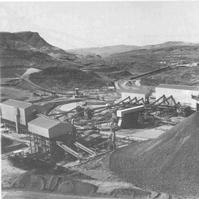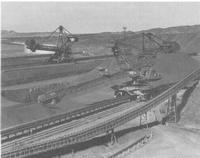


Chapter 6
I Construction During The Settlement Years
II The Use Of Timber As A Structural Material
III Structural Steel
IV Concrete Technology
V Housing
VI Industrialised Pre-cast Concrete Housing
VII Ports And Harbours
VIII Roads
IX Heavy Foundations
X Bridges
XI Sewerage
XII Water Engineering
XIII Railways
XIV Major Buildings
XV Airports
XVI Thermal Power Stations
XVII Materials Handling
XVIII Oil Industry
XIX The Snowy Mountains Scheme
XX The Sydney Opera House
XXI The Sydney Harbour Bridge
XXII Hamersley Iron
XXIII North West Shelf
Sources and References
Index
Search
Help
Contact us

The Hamersley Iron project in W.A.'s Pilbara, 1,600 km north of Perth, is recognised as a major world mining development of the 1960s. The scale and success of the original project has often overshadowed the continuing technical and scale developments up to the present. Major initial innovations of the project against other mining in Australia at the time included careful choice of major equipment for economies of scale and the successful establishment of modern air-conditioned suburban settlements in a harsh environment, then completely lacking all modern infrastructure.
The initial and successful project completion target of 19 months has become a benchmark with which later Australian construction performance is often critically compared. In these months were constructed a port to accept ships up to 100,000 D.W.T. capacity, 288 km of standard gauge railway designed for 30 tonne as against the then 20 tonne maximum axle load, and the initial Mount Tom Price mine to produce 5.5 mta of high grade iron ore entirely for export.
Project planning began some 2 years before the formal signing of the first 16-year sales contract in December 1964, and was based on a series of technical decisions to select the largest proven equipment available. Shovels were 12 cy capacity when common Australian usage was 5 cubic yards, trucks 100 tonne capacity against a common 35 tonne standard. Crushing plant choices followed conventional technology, but also with plant larger than previously used in Australia. These scale innovations were introduced successfully at the same time as the company provided, at its own cost, permanent infrastructures normally already in place in more settled areas. These included initially power, water, roads, communications and air strips, as well as temporary camps and later permanent settlements had to be provided. Project completion, though marked by formal ceremonies, shaded imperceptibly into continuous expansion, technical innovation, and up-grading of the available mineral resource to the present.
The original 5.5 mta at Mount Tom Price has now a capacity of 31 mta (Fig. 80). The later mine at Paraburdoo now has a capacity of 16 mta. The extended rail link from Tom Price to Paraburdoo completed in 1972 continued the initial innovations and scale of the railway system. Rail transport, apart from technical monitoring developments, is unusual in Australia for train size, mostly standardised on two 2,600 kw locomotives and 150 to 160 ore cars each carrying about 97 tonnes. The rail weight is 136 Ibs/yard laid on concrete sleepers (initially, 119 Ibs/yard rail was laid on jarrah sleepers). The rail is flash-butt welded into 396 metre lengths and 'Thermit' welded on site into continuous rail.

The export of iron ore can now take place at East Intercourse Island as well as at the original Parker Point (Figs. 81 & 82). Capacity has risen from the original 65,000 D.W.T, at all stages of tide at Parker Point to the present 140,000 D.W.T. and up to 220,000 D.W.T. at East Intercourse Island. Loading rates are 6,000 tonnes per hour and 7,500 tonnes per hour respectively.


Organisations in Australian Science at Work - Hamersley Iron; Mount Tom Price Mine, W.A.; Paraburdoo Mine, W.A.
People in Bright Sparcs - Hills, G. W.
 |
Australian Academy of Technological Sciences and Engineering |  |
© 1988 Print Edition pages 427 - 428, Online Edition 2000
Published by Australian Science and Technology Heritage Centre, using the Web Academic Resource Publisher
http://www.austehc.unimelb.edu.au/tia/428.html